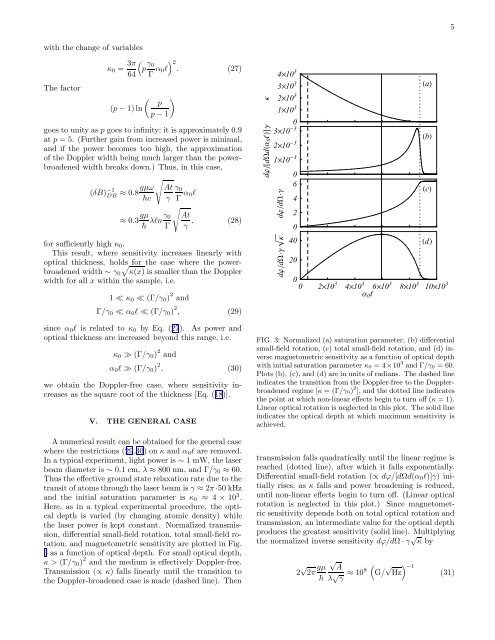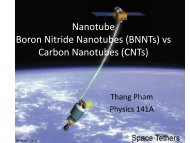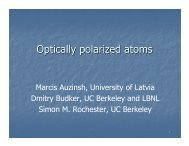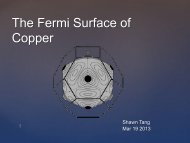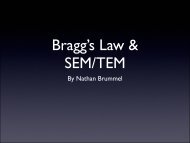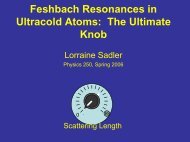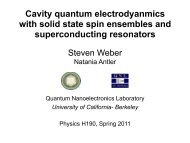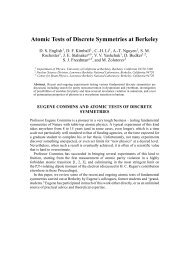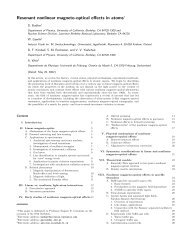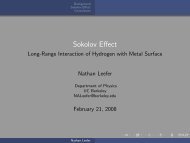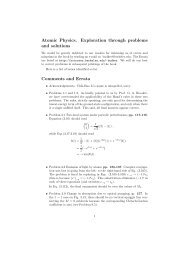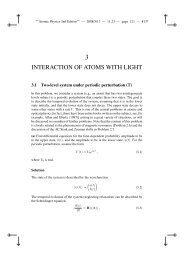Nonlinear magneto-optical rotation in optically thick media
Nonlinear magneto-optical rotation in optically thick media
Nonlinear magneto-optical rotation in optically thick media
You also want an ePaper? Increase the reach of your titles
YUMPU automatically turns print PDFs into web optimized ePapers that Google loves.
5with the change of variablesThe factorκ 0 = 3π (p γ )0 2.64 Γ α 0l(27)( ) p(p − 1) lnp − 1goes to unity as p goes to <strong>in</strong>f<strong>in</strong>ity; it is approximately 0.9at p = 5. (Further ga<strong>in</strong> from <strong>in</strong>creased power is m<strong>in</strong>imal,and if the power becomes too high, the approximationof the Doppler width be<strong>in</strong>g much larger than the powerbroadenedwidth breaks down.) Thus, <strong>in</strong> this case,√(δB) −1DB ≈ 0.8gµω ¯hc≈ 0.3 gµ¯h λlnγ 0ΓAt γ 0γ Γ α 0l√Atγ , (28)for sufficiently high κ 0 .This result, where sensitivity <strong>in</strong>creases l<strong>in</strong>early with<strong>optical</strong> <strong>thick</strong>ness, holds for the case where the powerbroadenedwidth ∼ γ 0√κ(x) is smaller than the Dopplerwidth for all x with<strong>in</strong> the sample, i.e.1 ≪ κ 0 ≪ (Γ/γ 0 ) 2 andΓ/γ 0 ≪ α 0 l ≪ (Γ/γ 0 ) 2 , (29)s<strong>in</strong>ce α 0 l is related to κ 0 by Eq. (27). As power and<strong>optical</strong> <strong>thick</strong>ness are <strong>in</strong>creased beyond this range, i.e.κ 0 ≫ (Γ/γ 0 ) 2 andα 0 l ≫ (Γ/γ 0 ) 2 , (30)we obta<strong>in</strong> the Doppler-free case, where sensitivity <strong>in</strong>creasesas the square root of the <strong>thick</strong>ness [Eq. (18)].V. THE GENERAL CASEA numerical result can be obta<strong>in</strong>ed for the general casewhere the restrictions (29,30) on κ and α 0 l are removed.In a typical experiment, light power is ∼ 1 mW, the laserbeam diameter is ∼ 0.1 cm, λ ≈ 800 nm, and Γ/γ 0 ≈ 60.Thus the effective ground state relaxation rate due to thetransit of atoms through the laser beam is γ ≈ 2π·50 kHzand the <strong>in</strong>itial saturation parameter is κ 0 ≈ 4 × 10 3 .Here, as <strong>in</strong> a typical experimental procedure, the <strong>optical</strong>depth is varied (by chang<strong>in</strong>g atomic density) whilethe laser power is kept constant. Normalized transmission,differential small-field <strong>rotation</strong>, total small-field <strong>rotation</strong>,and <strong>magneto</strong>metric sensitivity are plotted <strong>in</strong> Fig.3 as a function of <strong>optical</strong> depth. For small <strong>optical</strong> depth,κ > (Γ/γ 0 ) 2 and the medium is effectively Doppler-free.Transmission (∝ κ) falls l<strong>in</strong>early until the transition tothe Doppler-broadened case is made (dashed l<strong>in</strong>e). ThendφddΑ0{Γ Κ0310 3a210 3110 3310 30b210 3110 306c42040d2000 210 3 410 3 Α610 3{810 3 1010 3410 3dφdΓ Κ dφdΓFIG. 3: Normalized (a) saturation parameter, (b) differentialsmall-field <strong>rotation</strong>, (c) total small-field <strong>rotation</strong>, and (d) <strong>in</strong>verse<strong>magneto</strong>metric sensitivity as a function of <strong>optical</strong> depthwith <strong>in</strong>itial saturation parameter κ 0 = 4×10 3 and Γ/γ 0 = 60.Plots (b), (c), and (d) are <strong>in</strong> units of radians. The dashed l<strong>in</strong>e<strong>in</strong>dicates the transition from the Doppler-free to the Dopplerbroadenedregime [κ = (Γ/γ 0) 2 ], and the dotted l<strong>in</strong>e <strong>in</strong>dicatesthe po<strong>in</strong>t at which non-l<strong>in</strong>ear effects beg<strong>in</strong> to turn off (κ = 1).L<strong>in</strong>ear <strong>optical</strong> <strong>rotation</strong> is neglected <strong>in</strong> this plot. The solid l<strong>in</strong>e<strong>in</strong>dicates the <strong>optical</strong> depth at which maximum sensitivity isachieved.transmission falls quadratically until the l<strong>in</strong>ear regime isreached (dotted l<strong>in</strong>e), after which it falls exponentially.Differential small-field <strong>rotation</strong> (∝ dϕ/[dΩd(α 0 l)]γ) <strong>in</strong>itiallyrises, as κ falls and power broaden<strong>in</strong>g is reduced,until non-l<strong>in</strong>ear effects beg<strong>in</strong> to turn off. (L<strong>in</strong>ear <strong>optical</strong><strong>rotation</strong> is neglected <strong>in</strong> this plot.) S<strong>in</strong>ce <strong>magneto</strong>metricsensitivity depends both on total <strong>optical</strong> <strong>rotation</strong> andtransmission, an <strong>in</strong>ter<strong>media</strong>te value for the <strong>optical</strong> depthproduces the greatest sensitivity (solid l<strong>in</strong>e). Multiply<strong>in</strong>gthe normalized <strong>in</strong>verse sensitivity dϕ/dΩ · γ √ κ by2 √ 2π gµ¯h√A(λ √ γ ≈ 108 G/ √ ) −1Hz (31)


